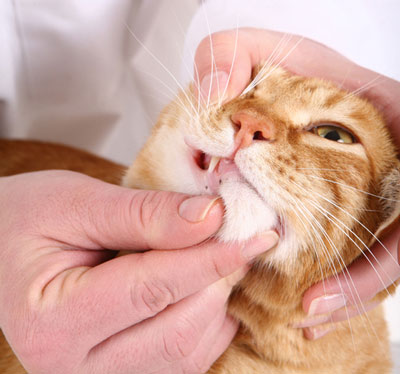Stomatitis in Cats

Stomatitis is a painful mouth condition that occurs in cats. Inflammation takes place in the gums, tongue, lips, and other tissues of the mouth, resulting in redness, ulcers, drooling, pain, and secondary infection.
What Causes Feline Stomatitis?
The exact cause of feline stomatitis isn't well understood. However, we know that certain conditions can predispose a cat to developing it:
- Stomatitis can be triggered by certain feline viruses, like FeLV or FIV.
- Dental disease can cause stomatitis. The bacteria around the gums can trigger an inflammatory reaction that develops into stomatitis.
- Immune-mediated causes are suspected in many cases of feline stomatitis. The body may mount an attack against its own mouth tissues or the immune system may over-react to the bacteria present in the mouth.
Signs of Stomatitis in Cats
The following signs may be seen in cats that are suffering from stomatitis:
- Drooling excessively
- Difficulty eating, sometimes tilting the head to move food around in the mouth, searching for a non-painful spot
- Poor hair coat as the cat stops grooming due to mouth pain
- Foul breath
- Pawing at the mouth
How Is Feline Stomatitis Diagnosed?
Your veterinarian may be able to examine your cat's mouth and develop a suspicion of stomatitis. However, the mouth is often so painful that sedation is necessary to examine it well.
Basic blood tests as well as specific ones for FeLV, FIV, and other feline viruses may be recommended.
Sometimes a tissue sample is taken from the mouth to examine under a microscope.
What Is the Treatment for Stomatitis in Cats?
Treatment of stomatitis is aimed at decreasing inflammation in the mouth. Antibiotics may be necessary to control secondary infections, pain medication can help keep the cat comfortable and eating, and steroids may be used to decrease the immune system's over-response.
Soft food may be recommended to help your cat eat with less pain.
Dental cleaning and extractions are often pursued to decrease the inflammation-causing gingivitis and periodontitis in the mouth, which may be triggering the stomatitis. Long-term care may include tooth brushing at home if possible.
If an underlying condition is found during testing, that will need to be treated to control the stomatitis.
Researchers have successfully treated stomatitis with stem cell therapy, and that may become a more widespread treatment in the future. Learn more here: "Stem Cell Therapy for Cats."
You May Also Like These Articles:
FIV: Feline Immunodeficiency Virus
Pet Insurance: Peace of Mind for Your Cat's Health
How to Be Prepared for Your Cat's Veterinary Bills
Why Should I Take My Cat to the Vet?
Notice: Ask-a-Vet is an affiliated service for those who wish to speak with a veterinary professional about their pet's specific condition. Initially, a bot will ask questions to determine the general nature of your concern. Then, you will be transferred to a human. There is a charge for the service if you choose to connect to a veterinarian. Ask-a-Vet is not manned by the staff or owners of CatHealth.com, and the advice given should not delay or replace a visit to your veterinarian.




